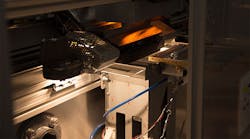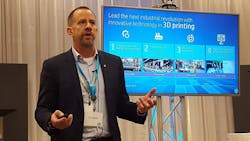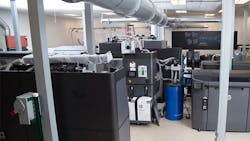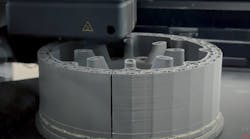SAN DIEGO — New products, new industries, new leadership and, of course, new companies. Yeah, these last two years have been unlike any in the nearly-eight-decade history of the tech leader formerly known as Hewlett-Packard.
Tim Weber was one of the hundreds of thousands of employees affected when the old company split back in November 2015 into Hewlett Packard Enterprise, which focuses more on services, software and financial, and HP Inc., which develops computers, printers and other related supplies. For years, Weber was responsible for a lot of that 2-D printer technology, especially from the ink jet standpoint, that so many of us use at home and at the office. “We built the print heads,” he said, “from $100 printers to $10 million printers.” Since late 2015, though, he has been the global head of HP’s 3-D materials and advanced applications.
“It was a bit of a new area,” Weber said, “but the way HP often works is we sort of sponsor new things in the core business. That’s what we were doing. A lot of things that go into 3-D are leveraged from 2-D. It was a very logical transformation. The difference is the business aspect of it. In 2-D land, the businesses have been set for HP for years. In 3-D land, we have the opportunity to kind of create some new business models in an open materials platform.
“That was a journey of discovery for me, and probably for others.”
HP has been on some kind of journey of discovery ever since, investing more and more resources into its burgeoning 3-D printing business. Its first announcements about the tech came just three years ago. It introduced the hardware last year, partnered with some big-name manufacturers (BMW, Johnson & Johnson, Nike and, as outlined in an IndustryWeek feature last year, Jabil Circuits were all foundational partners) and went about disrupting a disruptive industry. Earlier this month, company officials announced a move into Asia, and just last week, Investor’s Business Daily reported that HP’s scaling of its 3-D printing business could threaten market leaders 3D Systems and Stratasys. Heady times.
“We’ve reached the point where we are starting to scale the business,” Weber said. “We expect to sell a lot more units and we expect to start to see them going more from people just testing them out and prototyping to short-run manufacturing. Maybe customers who have one are looking to buy more and scale up. From a materials standpoint, we expect to start to introduce more and more materials on a regular basis. We’re letting the materials companies run with that.
“I think we’re most interested in working with folks who are thinking about 3-D from a transformational manufacturing standpoint. We chose all of (our foundational partners) because they’re not thinking about prototyping. They’re trying to figure out how to move into it from a manufacturing standpoint, and materials companies are the same.”
During a recent trip out west, I spent an afternoon talking with Weber and touring HP’s San Diego offices, where engineers are running countless tests on the still-new Jet Fusion printers and other 3-D materials. What follows is a portion of our conversation, edited for length and clarity.
Tim Weber, global head of HP’s 3-D materials and advanced applications. / Sarah Goehrke, 3DPrint.com
IndustryWeek: HP has generated so much buzz with its 3-D printing unit and with its return to industry and manufacturing, but it seems like the big challenge is just continuing to get the word out about all that. There are still misconceptions about what HP is.
Tim Weber: We started selling our first printers in the fall, … so we’ve now had two full quarters. Things are going fairly well and we’re sort of off to the races. I’ve had folks come up to me and ask, ‘When are you going to ship?’ We’ve been shipping for six months. Not betas, actually selling units to real customers.
The fundamental message at this (RAPID + TCT additive manufacturing event in May) was that we’ve now been in the market for six months, we purposely kept the ramp shallow, and we sort of learned the hard way in our graphics business that it’s better to learn on a smaller number of customers and units, and kind of get debugged before you scale. We’re now ready to scale. We have six months under our belts, we’ve made a lot of second-order improvements.
IW: What has the difference been over these last six or so months?
TW: We produce all our print heads, and do the development to produce them here and in Corvallis (Oregon). We have all the manpower and the brains, we’re able to quickly bring polymer chemists and folks that have been working in there to the 3-D land. We have all this materials expertise. We know how to jet fluids, and we can jet a shocking array of things. The new thing for us is the fusing system. Turns out, to create a part in the middle of your powder bed and have that part be the same as every other part and control that, that’s been a real challenge for us. At the same time, we believe it’s becoming a control point, and we’ve generated hundreds of patent disclosures — they’re not patents yet, but they’re basically in the system.
IW: The company has launched that focused effort to return to manufacturing, too.
TW: We see the opportunity to get into manufacturing as the real breakthrough. We think it can accelerate even beyond what current forecasts show, as companies start to jump across that chasm.
Making That Leap
IW: What are the obstacles still in the way of companies making that leap?
TW: We see six things that are key in advancing and jumping across that chasm. The first one is product capabilities. At the end of the day, we’re selling these things to mechanical engineers and designers. What matters is the material properties and what we’re delivering — parts. It’s not the printer, it’s not the powder, it’s the parts. From a customer standpoint, we’re fixating on that mantra.
Second is material price. In some cases, prototyping powders are $100 a kilo compared to maybe $5 or $10 for injection molding. We think that’s a huge barrier to entry for most people. How do we drive that down systematically over time? Some of that is volume, but we think there are ways to further reduce that.
Third is material selection. That was one of the things I realized a year and a half ago when I got into this job and my boss was saying, ‘We’re going to do this open-materials platform.’ Well, what does that mean? If you’re doing prototyping, materials matter, but they don’t really matter. You’re not worried about how long it lasts, whether it stands up to air or corrosive environments. If we’re going to be successful, we need to enable space that allows big OEMs with the materials companies to do what they’ve been doing since plastic was invented.
Design for additive is another. People don’t know how to design. It may be they have to bring computer capabilities, because a lot of generative designs are beyond what a human can sort of imagine, which are typically holes and straight lines.
Fifth is a new supply chain. How do we get these low-cost materials in? How do we build in an open materials platform? How do you track inventory over time? I think there are new opportunities here all the time.
Sixth is standards and regulations. We’re sort of holding ourselves to ASTM standards, but there will be new concerns because you’ll be able to do new stuff, and we recognize we need to participate, if not lead, in that area.
IW: You mentioned injection molding a minute ago. How does 3-D printing in general and what HP is doing specifically stack up to injection molding today? They both serve their purpose, and injection molding is still more widely used, but it seems like the gap has been narrowed a bit the last year or two.
TW: So our break-even is about 55,000 parts. If you were to do that from an injection molding standpoint, depending on how many parts you were building, it might cost between $10,000 and $50,000. If you print one part, that’s what it costs. Over time, you get to millions, you’ve amortized the cost of that mold and it’s basically the variable cost of the plastic. Most people don’t realize that we’re already at break-even at 55,000 parts, so if you’re building that many or less, it’s cheaper to print them. It’s going to be a function of the part size, but over time it will systematically come down. … People don’t realize we’re already there today for short-run production.
IW: What about other additive manufacturing technologies? How does HP’s Multi Jet Fusion tech compare to some more traditional modes? I’ve written about how larger contract manufacturers like Jabil are putting it to use, how smaller manufacturers are now getting into the game. What’s your stance?
The interior of an HP 3-D open materials development lab. / HP
TW: People often ask, ‘How does this stack up to the competition?’ When I answer it, I say, ‘Relative to injection molding, we’re getting closer. We almost have isotropic properties. From a manufacturing standpoint, that’s our competition. That’s what we have our sights set on. That’s what a manufacturer needs, from a parts standpoint and from a cost standpoint.
All the other 3-D technologies: FDM is basically a hot-glue gun on an x-y stage. It’s fine for form and fit, but it doesn’t have the structural properties. You sure wouldn’t want it holding something on the roof of your car, and you sure as hell wouldn’t want it holding an airplane together. SLS systems, the powder- and laser-based systems, are the closest thing to what we have, but they’re hampered by the speed. If you have a great big part, it takes a lot longer to print the whole thing. Then there’s the SLA, stereolithography, which is what carbon falls into and has the advantage of giving you very smooth surfaces because you’re using light instead of ink-jet. But it’s a photo-curable system, so you end up with the things that material brings to the table, cost and what have you.
IW: Take me through the FJM printing process.
TW: It starts with the MDK, which is, basically, get a powder you can spread. Turns out, powder is hard. That has been one of the technical things I’ve learned. It’s like a fourth state of matter. Powders behave differently, they flow, they clump, they do weird things, and you have to engineer it to make it work. The next step is a test bed. The print zone is maybe 4 inches by 4 inches by 4 inches, and we build things that let you test the mechanical properties, test the fusing recipes, how much heat you need to put in and extract.
Then we have our build unit. We have a printer and we have a post-processing station. It allows you to build continuously, but you’re now feeding powder through augurs and shakers to get that all out, and that’s a challenge, too. We go from needing a few grams of material to maybe 5 kilos to 50 kilos. When we have all that, then we put it into a production machine and we’re testing hundreds of kilos at a time to make sure it’s repeatable and accurate across an entire build across multiple machines. I think this is going to allow manufacturers to streamline and move quicker and quicker.
IW: Any major revisions or new iterations for the tech or the process?
TW: As we get our products out there, we’ll probably let the customers drive a lot of those applications. What do they want? Once you have mechanical engineers using that, what are they asking for? If we have 100 things to work on and we can pick five, we want to pick the ones that have some interest.
IW: HP seems to think this could be a really disruptive technology, not only within additive but across all industry.
TW: I think there are a bunch of things that are causing the next industrial revolution. What we’re bringing is something disruptive enough it will help those others reach a tipping point for the production of parts. By itself, it won’t be that, but with automation, with robotics, with artificial intelligence, it will be a tipping point. … We want to provide the world with a tool that allows materials companies to innovate with their OEMs and all the different verticals. It’s our gift to the world for this fourth industrial revolution.






